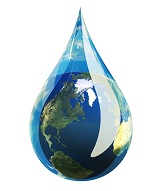 |
The Many Disadvantages of Reverse Osmosis Water Treatment
Article by Larry L. Taylor
What are the disadvantages of reverse osmosis? They are many. Does reverse osmosis make water safe to drink? Not any more.
Let's get right to the disadvantages of reverse osmosis. We will go into greater detail about each one, but first here is the short list. The system de-mineralizes and wastes water. Electricity is required to pressurize the source water. It cannot remove chemicals and other contaminants that are lighter than water. It does not protect users from bacterial contamination. Finally, it costs more than other systems that do a better job.
De-mineralization
One of the disadvantages of reverse osmosis from a health standpoint is that it de-mineralizes water. Trace minerals are important to human health. All naturally occurring water has some mineral content. Research has shown that drinking de-mineralized water on a regular basis caused digestive problems and nutritional deficiencies. So, does reverse osmosis make water safe to drink? It might be "safer", but it's not the best choice.
Waste
For every one gallon of water that is clean, anywhere from half a gallon to five gallons is wasted. Wasted water is one of the biggest disadvantages of reverse osmosis, from an environmental and financial standpoint. The most effective systems waste the most water. It is also a waste of electricity, because other systems work without pressurizing water and thus use no electricity. It is a waste of money, because it costs more initially. It costs more to maintain and it costs more to operate than other more efficient systems.
Chemicals Get Through
With all of the chemical pollutants in the environment, no one can doubt that they are in the water. So, when you ask, "does reverse osmosis make water safe to drink," the answer has to be "no". Chemical contamination is one of the biggest problems that we face. Over a thousand cancer causing chemicals have been found in tap water. From a health standpoint, this is one of the biggest disadvantages of reverse osmosis.
Bacteria Gets Through
There are several phases in the life of a bacterium. The earliest is similar to a microscopic egg. It is referred to as the oocyst, cyst or spore stage. Since, the cysts are lighter than water (they float through the air, until they find a host) reverse osmosis cannot block them. Cyst contamination is possible in any water source. The federal government says that detecting them in public drinking supplies is unfeasible. When people ingest them, they grow and cause illnesses ranging from a stomach ache to violent diarrhea. In children and those who are immune-compromised, they can cause death. If you have cyst contamination, the answer to "does reverse osmosis make water safe to drink" is a resounding "NO".
Price
If you are concerned about safety, price is largely unimportant. But when you consider that other more technologically advanced systems do a better job and cost less, you would be silly to spend the extra money. With all of the disadvantages of reverse osmosis, why would you pay over $10,000? You'll have to answer that question for yourself.
Larry L. Taylor is a dedicated advocate of living a healthy lifestyle and diligent researcher of water purification systems.
